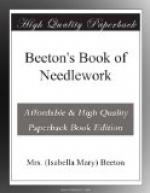[Illustration: 64.—Cravat End in Tatting and Darned Netting.]
The end of this cravat is ornamented with a square of darned netting, edged with a tatted border, and sewn on to the material of the cravat. But the diamond in tatting (page 18), or the square (page 31) will look very pretty with this border. The square is worked in diamond netting, and has seven holes in length and breadth. They are darned in linen stitch, darning stitch, and point d’esprit, with Mecklenburg thread. The ground is worked over a mesh measuring three-tenths of an inch round. For each square one more row than is needed must be worked, and the cast-on stitches are cut off, as they are longer than the stitches of the other rows. The tatted border is worked with fine tatting cotton. Fasten the cotton at one corner of the square and work * a circle consisting of 7 double, 1 purl, then six times alternately 2 double, 1 purl, 7 double, fasten the cotton on to the same stitch of the ground where it was first fastened; #work a second circle like the first, but fasten it, instead of working the first purl on to the last purl of the preceding circle; fasten the cotton again on to the same stitch, then on to the next stitch, and work a small circle, consisting of 5 double fastened on to the last purl of the preceding circle, 4 double, 1 purl, 5 double. The cotton is fastened on to the same netted stitch as before, and then on to the next stitch; repeat twice more from #, and then repeat from * in all three times more, so that the square is edged all round. It is sewn into the material from the illustration.
* * * * *
65.—Tatted Antimacassar. (See pages 574-5.)
Materials: Messrs. Walter Evans and Co.’s Boar’s Head cotton No. 30, or tatting cotton No. 24, or for a larger size tatting cotton No. 20; tatting-pin No. 1; large shuttle.
The illustration shows the fourth of the antimacassar and the whole of the rosette which forms the centre. Begin with the latter, with the five-branched pattern in the centre, at the same time with the following round of circles:—Work first one circle of this round, consisting of 3 double, 1 purl, 4 times alternately 2 double, 1 purl, 3 double; then at a short distance a circle like the one just made, in which, however, instead of working the first purl, the cotton must be joined on to the last purl of the preceding circle. Then work at a short distance the first leaf of the five-branched pattern, which consists of 4 double, 1 purl, 4 double. When this branch is completed, repeat at a short distance 4 times more from ; but in working the branches of the five-branched pattern, instead of working the purl, join it on to the purl of the first branch of the five-branched pattern (this purl forms the centre of the pattern). All the circles must also be joined one to each other, as can be seen from illustration. Then work the scallops round the border of the rosette, * fasten the cotton on to the purl which joins the two next circles of the preceding round, and work one scallop consisting of 11 times alternately 2 double, 1 purl, then 2 double. Repeat 9 times more from *. When the rosette is completed, work eight rosettes in the same manner and join them into a circle from illustration by means of small three-branched patterns, and then join them on to the middle rosette.




